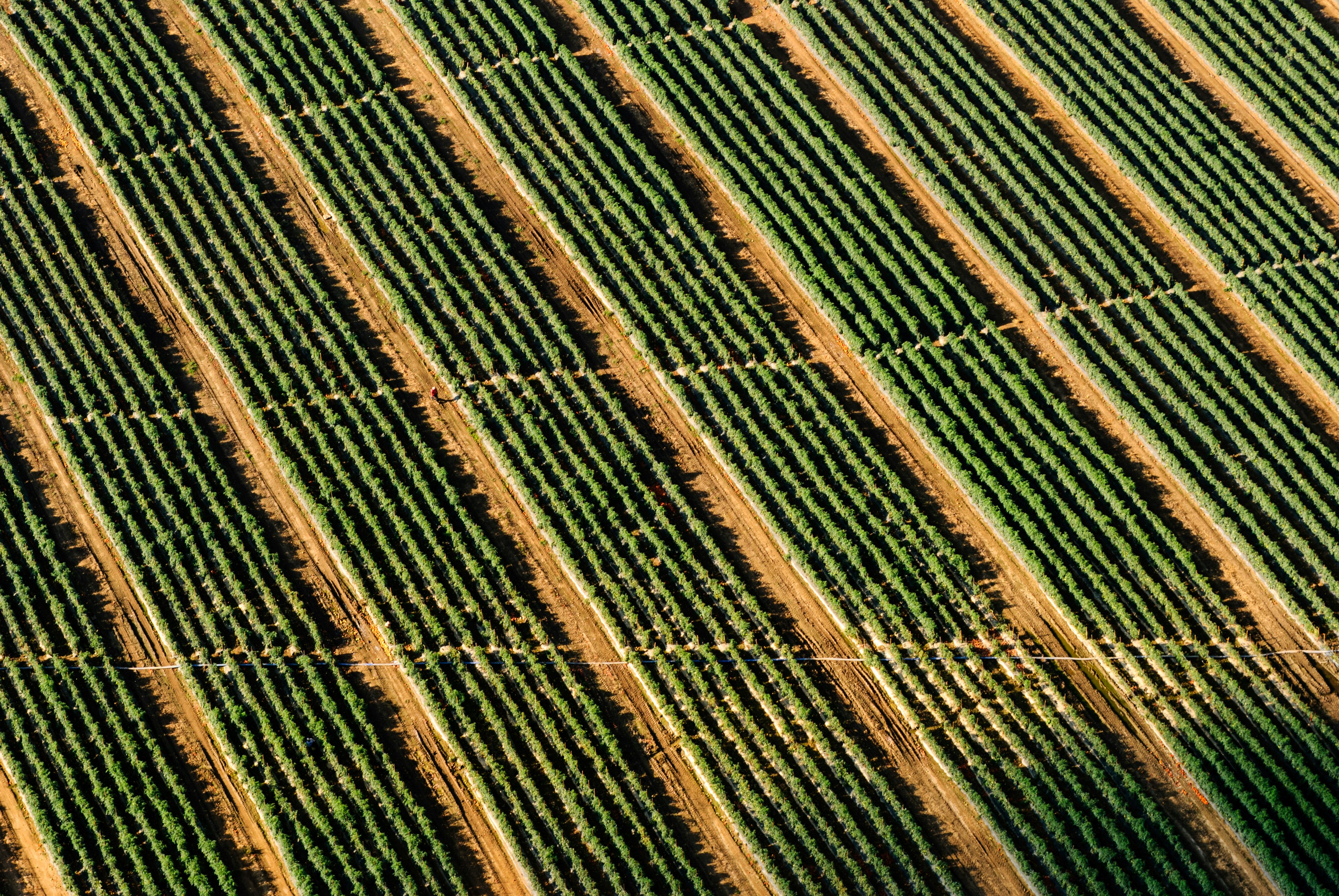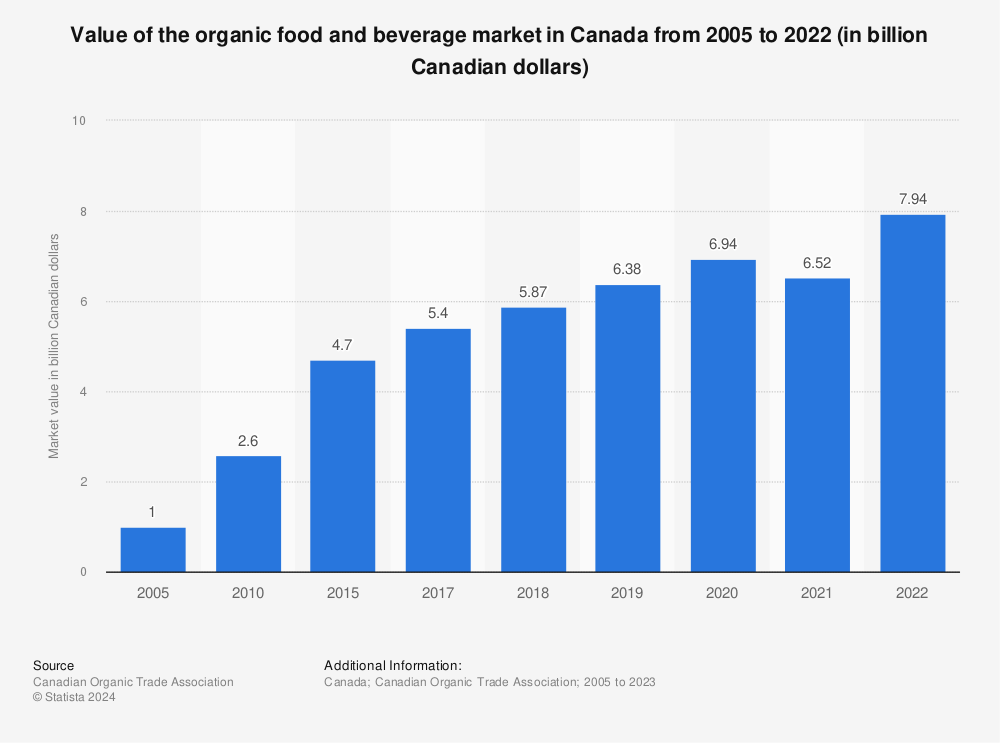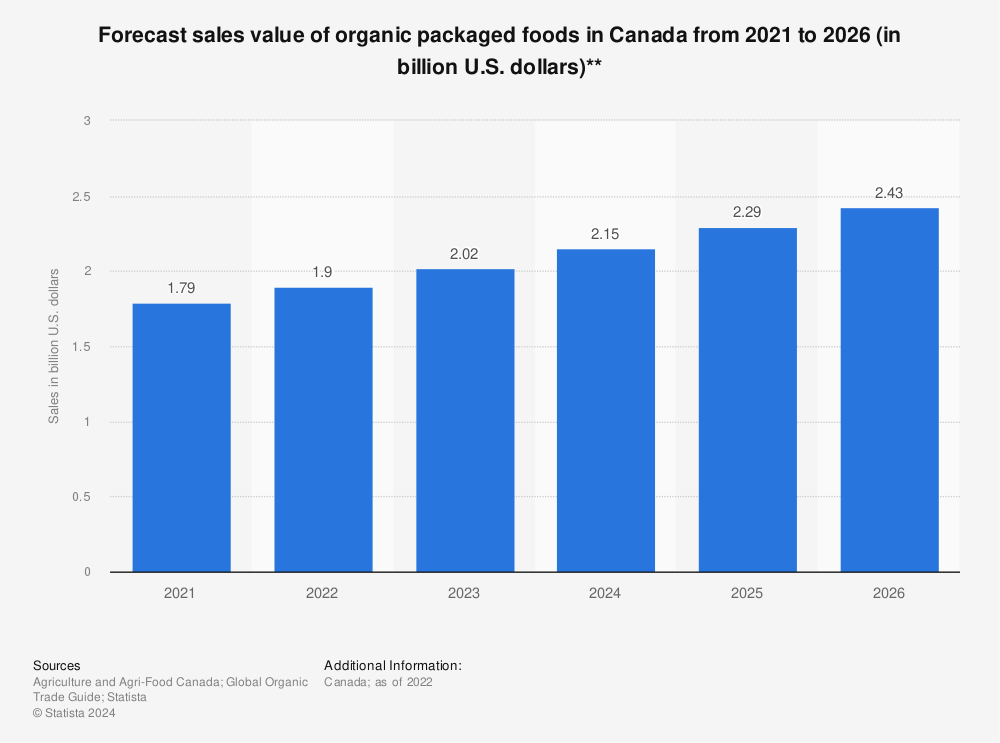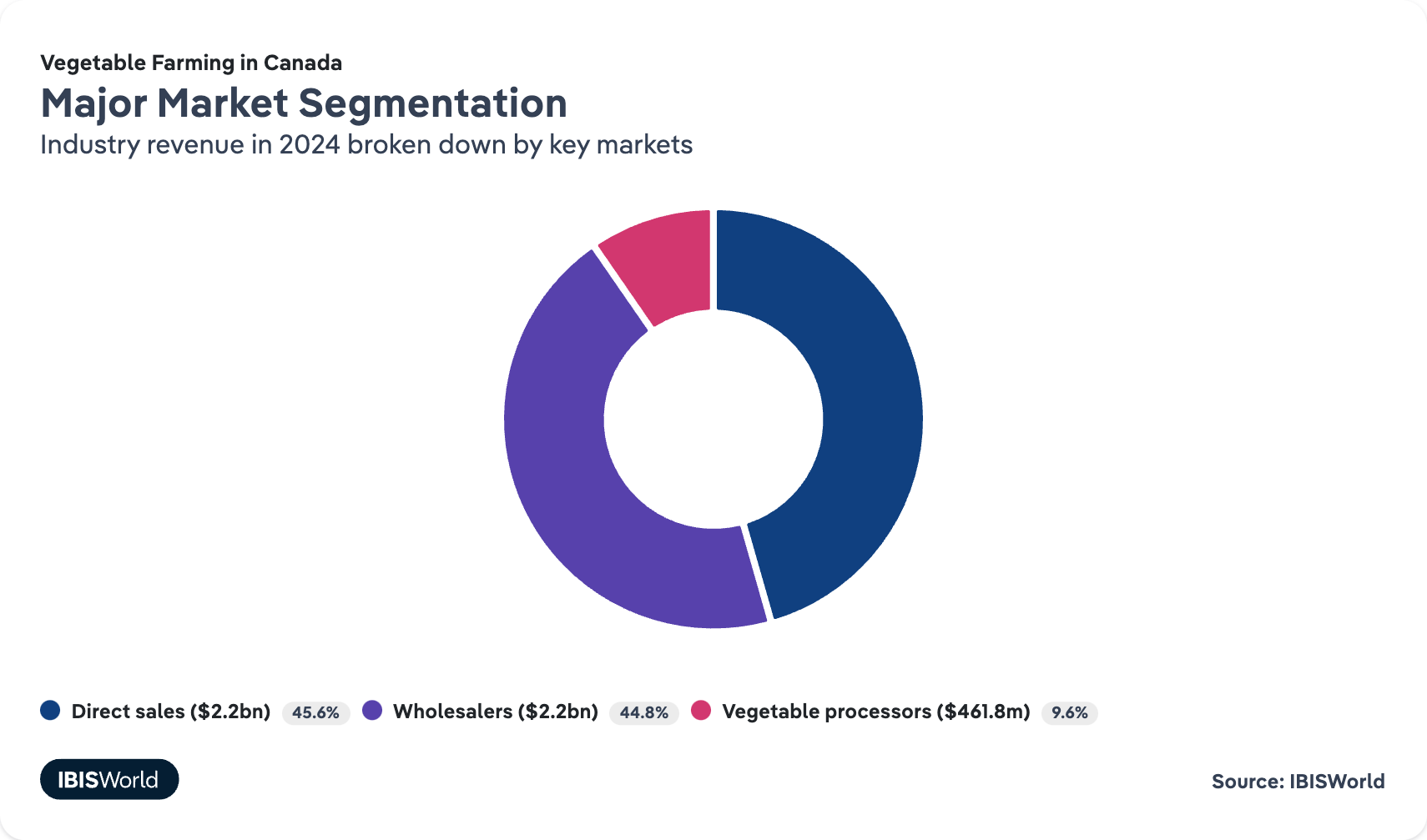
Photo by Matt Benson on Unsplash
Key Takeaways

- Organic food is a gateway to the organic industry as a whole, with food making up 6.2% of the market share (Loftsgard, 2024). Within the organic food market, Meat, Fish, and Poultry is the leading category within Canada by percent share (Marketline, 2022).
- Consumers of organic food in Canada tend to be on the younger side (Marketline, 2022). According to a survey conducted by the Canada Organic Trade Association, organic goods make up nearly half of weekly grocery purchases for centennials (aged 18-24) and 32% for millennials. Compared to just 23% of 18-34 year olds, 57% of Canadians aged 55+ say they are not willing to pay premium prices for organic food.
Industry Performance Snapshot

- Other than a slight dip in 2021, the value of the organic food and beverage market has been rising steadily since 2005 (Shahbandeh, 2023b).
- However, the climate has posed problems in years past. The growing season is substantially warmer, affecting yield and profit for vegetable farmers (McGrath, 2024), and Agri-Food Canada reported that, as of March 31, 2024, more than 65% of Canada was “abnormally dry” (McGrath, 2024, p. 19). Last year’s dry season “fuelled record-setting wildfires” (Tait, 2023, p. 1).
- Canada only accounts for 9.5% of the Americas’ organic food market value as of 2021 (Marketline, 2022). The United States holds 88.3% of the market, with the remainder (2.2%) coming from the rest of the Americas.
Industry Outlook

- The sales value of organic packaged goods is forecasted to steadily rise through 2026 (Shahbandeh, 2023a). Between April 2021 and April 2024, “prices for food purchased from stores increased 21.4% (Statistics Canada, 2024a). However, the Consumer Price Index has grown at a slower pace, largely due to a “base-year effect in prices for fresh and frozen beef.”
- “The value of the Canadian dollar is forecast to peak in 2025,” but this will be followed by “depreciation to close to pre-pandemic levels” (McGrath, 2024, p. 24). Import competition will remain fierce for vegetable farming despite domestic produce being more valuable.
Farming Industry Trends

- Small farmers are increasingly “circumventing the middleman and selling directly to individuals” (McGrath, 2024, p. 34; Marketline, 2022). By offering fresh products in a timely manner, farmers with short supply chains can benefit from a higher price point (Mosadegh Sedghy et al., 2024).
- “Healthification” is a growing trend that’s driving consumers to purchase more fruits and vegetables (BMI, 2024, p. 11). Organic food, a key part of this trend, tends to be more expensive, but Canadian households are positioned to be strong consumers. In the first quarter of 2024, household disposable income increased by 1.8% and spending increased by 0.7% (Statistics Canada, 2024b).
- The climate will be a continuous challenge, as “warmer growing season temperatures mean greater crop water requirements” (McGrath, 2024). Intense heat also causes dairy cattle to produce less milk, and if the long-term forecast is correct, “average global crop yields for maize or corn may see a decrease of 24 per cent by late century” (MacDonald, 2024).
- The agricultural industry is becoming heavily mechanized, replacing human labour with automation (McGrath, 2024). Mechanization means farmers are less reliant on wages, potentially boosting profit for vegetable farmers. However, new technologies such as an intelligent irrigation system, disproportionately benefit larger farms in initial stages of integration (Kumar, 2024). Small farmers receive “only marginal benefits for their investments, alongside a mountain of debt” (Bloomfield, 2023).
Sources
Bloomfield, R. (2023, December 20). Canada's agricultural policies need to better serve local farmers and communities. Record. Retrieved from https://www.proquest.com/newspapers/canadas-agricultural-policies-need-better-serve/docview/2904035832/se-2.
BMI. (2024). Canada Food & Drink Report, 2, 1–73. Retrieved from https://search.ebscohost.com/login.aspx?direct=true&AuthType=shib&db=bsu&AN=176458058&site=ehost-live&scope=site&custid=s5672194
Kumar, G. K., Bangare, M. L., Bangare, P. M., Kumar, C. R., Raj, R., Arias-Gonzáles, J. L., Omarov, B. & Mia, M. S. (2024, January 11). Internet of things sensors and support vector machine integrated intelligent irrigation system for agriculture industry. Discover Sustainability, 5(1). Retrieved from https://doi.org/10.1007/s43621-024-00179-5
Loftsgard, T. (2024). The world of organic agriculture: statistics & emerging trends 2024 [White paper]. Research Institute of Organic Agriculture FiBL. https://www.fibl.org/fileadmin/documents/shop/1747-organic-world-2024_light.pdf
Macdonald, V. (2024, March 5). Rebuilding the beef herd expected to take more time; while US beef feedlot placements are higher in the short term, strength of demand is a concern for the mid-term. Ontario Farmer. Retrieved from https://www.proquest.com/magazines/rebuilding-beef-herd-expected-take-more-time/docview/2937552984/se-2.
MarketLine Industry Profile: Organic Food in Canada. (2022). Organic Food Industry Profile: Canada, 1–45. Retrieved from https://search.ebscohost.com/login.aspx?direct=true&AuthType=shib&db=bsu&AN=156453704&site=ehost-live&scope=site&custid=s5672194
McGrath, S. (2024, May). Vegetable farming in Canada: Industry report 11120CA. IBISWorld. Retrieved from IBISWorld Industry Reports.
Shahbandeh, M. (2023a, December 20). Forecast sales value of organic packaged foods in Canada from 2021 to 2026 (in billion U.S. dollars)** [Graph]. In Statista. Retrieved June 12, 2024, from https://www.statista.com/statistics/750014/sales-value-organic-packaged-foods-canada/
Shahbandeh, M. (2023b, November 24). Value of the organic market in Canada 2005-2022 (in billion Canadian dollars) [Graph]. In Statista. Retrieved June 06, 2024, from https://www.statista.com/statistics/738579/organic-food-market-value-in-canada/
Statistics Canada. (2024a, May 21). Consumer Price Index, April 2024. https://www150.statcan.gc.ca/n1/daily-quotidien/240521/dq240521a-eng.htm
Statistics Canada. (2024b, May 31). Gross domestic product, income and expenditure, first quarter 2024. https://www150.statcan.gc.ca/n1/daily-quotidien/240531/dq240531a-eng.htm
Tait, C. (2023, July 5). Southern regions deal with drought after hot spring: Dry weather that fuelled headline-grabbing wildfires has been hampering crops. The Globe and Mail. Retrieved from https://www.proquest.com/newspapers/southern-regions-deal-with-drought-after-hot/docview/2832977227/se-2



